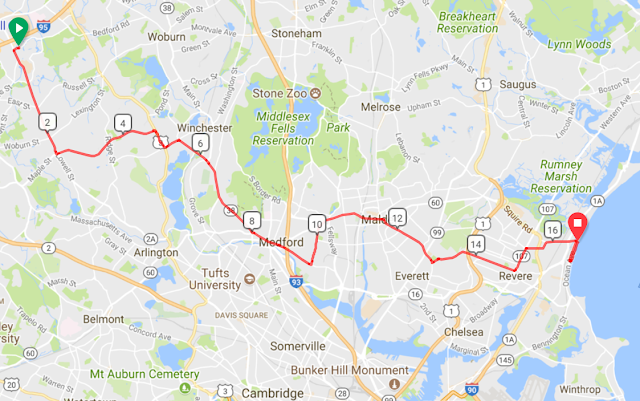Day 31 - Monday, June 11th - Quincy to Springfield, IL
Distance: 106.9 miles
Elevation Gain: 2296 ft. or 21.5 ft./mile
Net elevation change: -144 ft.
Unfortunately there won't be any pictures for a few days. The point and shoot camera that I was using popped free while on the downside of the bridge crossing the Illinois river...a bridge with no shoulder and one lane each way. While Mark was actually able to retrieve it, it wasn't before at least one of the 18 wheels on the truck that was behind us ran over it. I offload the pictures at the end of each day, so I reckon I only lost 5 pictures max. Tomorrow we get to Champaign and have a rest day so I figure I should be able to replace it. From a picture perspective we aren't missing much from today. LOTS of cornfields especially after the first 40 miles when the terrain really flattened out. Everywhere you looked...cornfields.
Today was our fourth century of the tour leaving just one more. That big dip in the road profile above is the Illinois river. In reality the roadway did not drop off quite as dramatically as illustrated, nor did is ascend that dramatically on the other side. We had cloud cover for most of the day, but this only tempered the build up in heat and humidity. In addition to our two SAG stops I made considerable use of the convenience stores along the way to hydrate and borrow their AC. Made for a very long day and only aggravated by the 5-10 mph headwind.
Out of the hotel we headed east on IL-104 and passed the Quincy Regional Airport at the eight-mile mark and two miles later the road turned southeast. At mile 15 we reached Liberty, a village of about 500 people founded by Daniel Lile in the spring of 1822.
We continued for another six miles and at mile 21 the road turned more to the east and by mile 29 we reached the unincorporated community of Fishhook where Robert Earl Hughes, once billed as the world’s largest man by the Guinness Book of World Records, grew up.
At mile 41 we reached the small community of Chambersburg and another five miles down the road we crossed the Illinois River and entered Meredosia, a village of just over 1000 people originally named by the French as Marais d'Osier which means willow swamp. In 2011 Ameren Energy resources closed its power station in Meredosia causing the loss of 50 jobs. There is some talk that it may be reopened as a clean coal test facility. Frank Skinner, a film composer and arranger of American films was a native of Meredosia. He started in vaudeville and formed a dance band with his brother and they played on steamboats going up and down the Illinois River. In his 30-year career working at Universal Studios he composed music for more than 200 films and earned five Oscar nominations.
Right before we got to mile 50, IL-104 turned southeast and merged with US 67 which we followed to the village of Chapin at mile 57. Founded by Charles and Horace Chapin it has a population of close to 600.
At mile 65 we turned due east onto Morton Ave (Old Route 36) and entered Jacksonville, a city of close to 20,000 and the county seat of Morgan County. Jacksonville was settled by European Americans in 1825. The city grew rapidly and by 1834 it was the largest populated city in Illinois (Chicago was only founded the year before). The Potawatomi Indians passed through here in 1838 on what was know as the Trail of Death as they were forcibly removed from their ancestral lands. Jacksonville is also the home of the Eli Bridge Company, the manufacturer of Ferris Wheels and other amusement rides such as the Scrambler.
At mile 80 we went through the unincorporated community of Alexander and at mile 86 New Berlin, a village of about 1100 founded in 1865 by a community of mostly German immigrants.
At mile 94 we reached Curran, a village of 200 incorporated in 2005, where we turned south for a little over a mile before turning east on Spaulding Orchard Road which took us into Springfield,
Sneak Peek at Tomorrow
88 miles into Champaign and our fourth rest stop tomorrow. Champaign is a city of over 85,000 that was founded in 1855
when the Illinois Central Railroad laid its track 2 miles west of downtown
Urbana. Originally known as West Urbana, it was renamed in 1860 when the city
acquired a charter. In 1985, the city
hosted the first Farm-Aid concert raising $7 million for American family
farmers.





Comments
Post a Comment